What does it take to come up with cool landscape shots? Those images that make you feel like picking up your old hiking shoes and heading out for the wild. Those images that bring back a bit of nature in the house to remind you that there are mountains beyond the skycrapers blocking the view.
Some will argue that subject is the main thing. Others will insist on creative vision, style and talent. On top of that, millions of photography forum gurus will swear to you that nobody stands a chance without the latest Canon or Nikon DSLR.
They might be right. But I feel that there are more than these obvious elements. Much more.
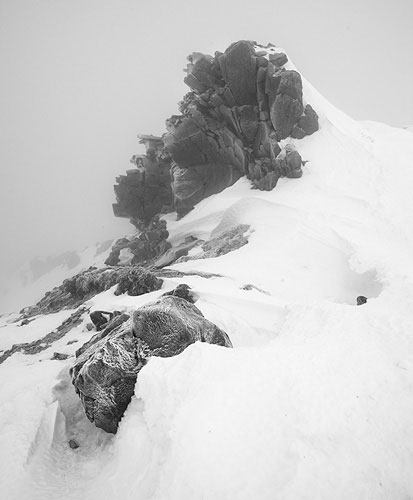
Frost explosion – Japan, Akadake – Mamiya ZD
I have been trekking extensively as an amateur photographer for many years. I must have taken around 200,000 images during that period. That’s a lot considering that I am not really a crazy snapper. The truth be told, I am only totally happy about a tiny fraction of these shots. The places I went to were breathtaking; I was using some of the best gear around…. Are my failures the result of a lack of creative vision and talent? Probably so. But aren’t there other factors coming into play?
In this short essay, I’ll try to review some aspects I feel have contributed to my past failures. Or… I’ll look at them the other way around, as items that should be improved on in order for us to be able to fully tap into the creative potential we have been gifted with. Better yet, we’ll even try to come up with some ideas on how to make these things easier to reach… aren’t we nice?
____________________________________________________________________________________
Mental Fitness
Anyone can take great images from the side of the road. Stop the car, grab the tripod on the rear seat and snap away. Except that I have rarely found side of the road locales to be as exciting as those 10 miles away from the road. Things get more complicated then. Exhaustion slows you down, gear fails and your best friends turn into monsters that seem to hate the very idea of you making one more stop to take that last super image of the sunset…
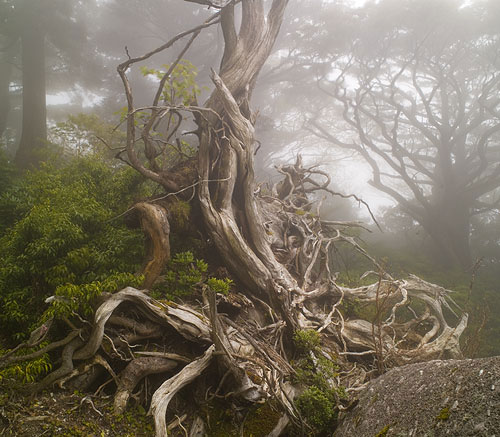
Rooted in time – Japan, Yakushima – Mamiya ZD
For me, mental fitness means:
* Ability to concentrate on technique even when the body is tired or still half asleep. It always amazes me how easy it becomes to overlook obvious things (like using a PL filter,…) after 6 hours of strenuous walk or at 3:30 AM after only 4 hours of sleep.
¡ Solution: practice and experience. Turn into a robot for which the execution of basic technical tasks can be triggered by the press on a mental button. The less you change gear, the better you’ll become,
* Ability to stay flexible and open minded even when the going gets tough (weather, technical difficulties,…). Even then, one should be able to adapt to the actual opportunities provided by the terrain, and not only to zombiexecute a plan defined in advance,
¡ Solution: This state of mind can be worked on. Memorizing a list of challenges to achieve and monitoring constantly the situation against those can be a great way to remain mentally awake when things get hard,
* Mastery of the mental energy it takes to get up early and get out there even if the chances that it works are few. Man, those Thermarest mats are so comfortable, why the heck should we stand 30 minutes in the cold to get some shots?
¡ Solution: Making it as little painful as we can to wake up, prepare this little extra incentive that will make you want to leave the comfort of the tent (a good-looking partner can help but a cup of Jamaican Blue Mountains Coffee can do the trick as well),
* Ability to deal with the social aspects of an expedition to make photography an accepted dimension of the trip. Some places are just too dangerous to get to on our own, besides having friends along makes the whole experience so much more pleasant… As long as it stays pleasant for them as well…
¡ Solution: know the people you walk with, share your intentions and be sure to always prioritize your friend’s comfort, safety and pleasure on top of your own photography,
* Ability to enjoy challenging conditions instead of resisting to them. Suffering from time to time is OK, but if photography in the outdoors becomes sufferings alone, the days are counted. There is a certain state of mind in which tougher become funnier. Going too far can result in stupid accidents, but learning to like physical challenges is a valuable skill.
¡ Solution: Beyond the easy "some people have it, some don’t", this can be improved on. Experience improves our ability to assess a situation and can bring a certain level of comfort of mind. There is a way out. Competition can also help finding motivation where none seems to be found. Again, knowing where to stop is just as important.
Don’t overdo it. There is always a next trip and burning out your motivation this time wouldn’t be smart.
____________________________________________________________________________________
Physical condition
Say you have turned into a titanium willed person. The Bjorn Borg of photography. Some of your friends call you Iceman. Is that going to be enough to get to the place you want to be at, while carrying all the gear you need to carry?
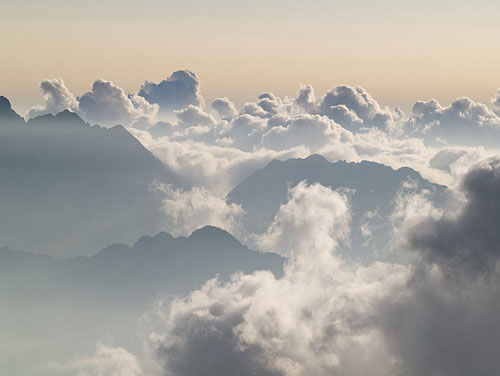
Above it all – Japan, Karamatsu dake – Mamiya ZD
In corpore sano. The body matters as well…
* Ability to carry the entire gear mandatory for safety as a baseline before starting to think about photography, and then add the 6 kg of a typical landscape kit… In the process, don’t forget about the influence of seasons, winter gear is a lot heavier,
¡ Solution: there is not better way to get fit for walking than walking itself, maintain a regular stream of physical activity, invest into light gear starting with the heavy items like camera gear (body, tripod, tripod head and long zooms), the pack itself, the sleeping bag,
* Ability to reach the target place in due time (camp,…). Heck, having to bivouac on an exposed ridge 2 km before the target camp isn’t the best way to get ready for nice sun rise images the next morning,
¡ Solution: this is impacted by the ability to plan a route well, somehow manage the picture taking along the road, take into account the weak members of the group (including yourself), your condition on that day and the overall environment (trail condition, weather,…)
* Ability to get low, sprint to the top of that hill, become silent as an eel. All things that require a sufficient level of fitness when combined with the rest,
¡ Solution: Sorry, no miracle recipe here, only… practice, practice and practice.
* Ability to cope with un-expected opportunities on the way on top of the baseline plan. There are always some un-planned opportunities and those are often the best. Without a reasonable safety margin you won’t be able to tap into those,
¡ Solution: plan with enough safety margin to be able to enjoy the ride. The less you are familiar with the area, the larger the safety margin you should take.
* Improve these outdoor skills. A skilled outdoor person will go farther using less energy. She will manage to overcome difficult situations will less stress and more fun.
¡ Solution: reading books does help, but there is nothing like first hand experience out there in the field where wet hairs prevents you from reading the compass while this persistent rain has started to soak your left shoulder. Locating a skilled person and negotiating some hands on outings is really the best way to learn quick.
All in all, if you haven’t been able to get as fit as you expected, what really matter is to be totally realistic about your true abilities when planning a trip.
____________________________________________________________________________________
Logistics
Being at the right place, at the right time with the right gear… isn’t that what it’s all about? Improvisation isn’t the right approach.
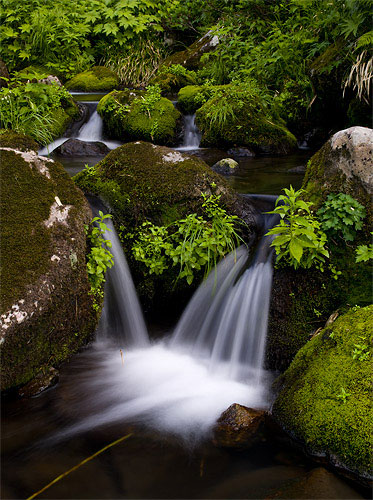
Cool bits – Japan, Gassan – Mamiya ZD
Think ahead and get ready for the D day.
* Be able to select the right set of gear as a function of the trip overall planning (accommodation, means of transportation to the start, means of locomotion…), expected terrain, size of the group,… Weight is nearly always a problem. Carrying too much can hurt as much as not carrying enough. There really is only way to handle this matter, and it is the right way.
* Photographic (including back ups for key items including the body itself and the images already shot),
¡ Solution: know you gear, what you will need for the terrain and opportunities most likely to show up. Think back up only for those items that would mean the end of everything if they were to fail,
* Outdoor gear (snow shoes and/or crampons,…).
¡ Solution: invest as much money as you can into light stuff, review after each trip what you did and didn’t use and take that into account for the next outings. Maintaining check lists of gear to take along for various configurations can proof very helpful as well,
* Plan the trip so as to maximize opportunities. A good look at a map can reveal a surprising lot about the vistas to be expected. Looking at previous work shot in the same locale can provide excellent information as well.
* Camp location. It goes without saying that early and late lights being what they are, it is key to stay at the right location. Moving at night should best be avoided,
* Route planning as a function of the respective location of the sun vs the interesting features of the terrain,
* Factor in seasons in the equation for optimal blend.
¡ Solution: Review you previous walking times on the same spot, or talk with people who have been there before. Check out the map for interesting features of landmark places and decide in advance where you want to shoot what from, and under what light.
* Favor well known gear over the latest stuff. Know the potential weaknesses of each piece of equipment identify which failures would be critical and plan a B plan for these. Something is going to go wrong; the only question is what and when. Using unknown gear during an important outing is a recipe for disaster. A 6MP image taken with your old Canon 10D will always be superior to a 22MP image not taken with a Mamiya ZD that ran out of battery,
¡ Solution: Keep logs of the usage of your gear so as to be able to anticipate failures, check out internet forums to learn about known weaknesses, plan your purchase of important pieces of new gear relative to your critical outings so as to be able to try things out before the big day,
* Manage risk
* losing a camera after 2 days amidst a 2 weeks assignment is a disaster, losing it on the last day is less of a problem,
* There is always a next trip that is also going to be great, getting injured now is poor style.
¡ Solution: define clearly in advance the part of trip that is most important for you, and act accordingly.
* Avoid wasting time looking for important items when the tension get right
¡ Solution: pack the right way:
* Know where everything is in your pack. The ability to react quickly is essential in many situations, would it be to take that one amazing image, or to help a friend in danger. Maintaining a very clear and up to date mental image of the exact location of all the items carried along helps a lot in these high stress situations,
* Put items in the bag in the order they will probably be used when in the field (most important items on top),
* Pack dangerous items like water lower than valuable equipment like your camera… that saved my day last month again when a loosely screwed Camel water tank leaked on me,
* Know what equipment other members of the group carry. Some of the value of belonging to a group is the ability to divide the burden between the members, communication is key to make the best possible use of these possibilities
* Pack the night before an early outing. Ever forgotten that head lamp or the cable release in the side pocket of the tent?
The more you shoot in a given environment, the easier these things become. Let’s not forget to re-think the approach when we move to a new environment… A Japanese friend of mine often says "you have to find your mountain, the one you’ll love and know better than anyone else".
____________________________________________________________________________________
Conclusion
These pointers have helped my outdoor photography. I am very much in the process of trying to improve on all of these points as new dimensions appear along the way. Each of us, depending on the photography we like, will probably end up focusing on different areas of personal development.
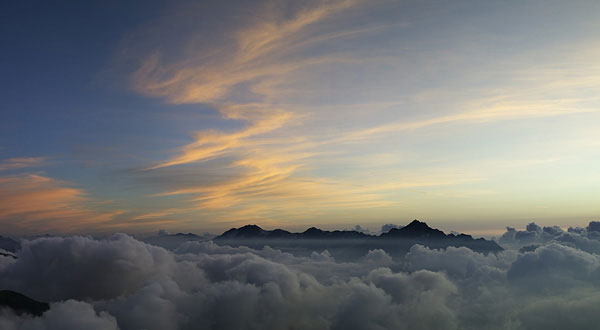
Tsurugi dake – Japan, Karamatsu dake – Panorama made from 4 Mamiya ZD images
Beyond the rate of enhancement, the very process of improving is probably the most valuable aspect of the approach.
How about starting to audit your own past failures as well? Awareness is a key step in defining solutions that are likely to open up new doors.
Bernard Languillier is a landscape photographer based in Tokyo, Japan.
Some of his work can be seen online atwww.light-of-earths.com
November, 2007
